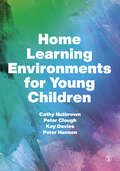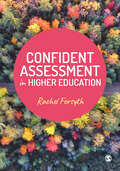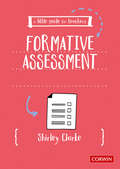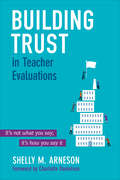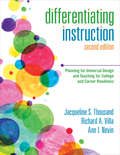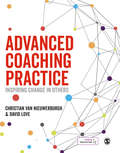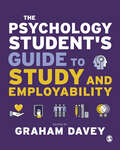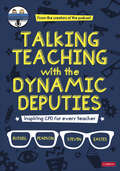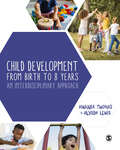- Table View
- List View
Deep Learning: Engage the World Change the World
by Michael Fullan Joanne Quinn Joanne J. McEachenEngage the World Change the World Deep Learning has claimed the attention of educators and policymakers around the world. This book not only defines what deep learning is, but takes up the question of how to mobilize complex, whole-system change and transform learning for all students. Deep Learning is a global partnership that works to: transform the role of teachers to that of activators who design experiences that build global competencies using real-life problem solving; and supports schools, districts, and systems to shift practice and how to measure learning in authentic ways. This comprehensive strategy incorporates practical tools and processes to engage students, educators, and families in new partnerships and drive deep learning. Inside you’ll find: The Deep Learning Framework Vignettes and case studies from K-12 classrooms in 1,200 schools in seven countries Guidance for reaching disadvantaged and differently abled students Sample protocols and rubrics for assessment Videos demonstrating deep learning design and innovative leadership in practice Through learning partnerships, learning environments, new pedagogical practices, and leveraged digital skills, deep learning reaches students as never before — preparing them to be active, engaged participants in their future.
Home Learning Environments for Young Children
by Cathy Nutbrown Peter Clough Peter Hannon Kay DaviesBy bringing together research evidence on effectively supporting parents to engage with their children’s early learning, and the role of education professionals in developing partnerships with families, this book focuses on partnerships between professionals and parents to enhance family learning for young children in literacy and other aspects of early learning. The move towards setting, home-based, and online learning has accelerated, and it is important for both students and practitioners to value parents’ roles in their young children’s learning; to consider how parents can support young children’s learning in these scenarios, and how to apply this in practice with children aged birth to five. Through a wealth of case studies from real experience, the authors showcase an inspiring range of inclusive projects and approaches with families, including marginalised groups such as bilingual learners, fostering families, and families identified as ‘vulnerable’ including imprisoned fathers and children with specific learning needs.
Confident Assessment in Higher Education
by Rachel ForsythYour perfect companion to building confident assessment in teaching and learning in higher education. Assessment is a central part of teaching and learning in higher education and an area in which many university teachers lack confidence. Designed to work across academic disciplines, this is a practical, theory-informed resource for anyone in the higher education sector. It offers an in-depth view of assessment, exploring current practice and contemporary challenges. It offers guidance on contextual assessment design and the teaching that can support this, alongside a deep dive on marking, feedback and common assessment challenges. The final third of the book offers practical templates for a wide range of common assessment types including case studies, competence portfolios, essays and dissertations. Rachel Forsyth is an educational developer who works at Lund University, Sweden.
Think!: Metacognition-powered Primary Teaching (Corwin Ltd)
by Anoara MughalThe perfect guide to help you embed metacognitive approaches to your teaching. What is metacognition and how can you use it in your teaching? Metacognition – being aware of our own ways of thinking – is popular in education, but it is not always obvious how it links to teaching practice and how to teach it explicitly. This book translates meaningful concepts from research literature not only into practical strategies to try in your classroom but also gives you the opportunity to reflect on metacognitive strategies that you already use. Key topics include: Metacognitive strategies in a range of subjects, including English and mathematics Dismantling metacognitive misconceptions How to use metacognition to improve test performance The importance of developing a growth mindset How to develop self-regulation in the classroom
A Little Guide for Teachers: Formative Assessment (A Little Guide for Teachers)
by Shirley ClarkeBridging the gap between research and practice A Little Guide for Teachers: Formative Assessment gives teachers practical tried and tested strategies to put formative assessment into action in their classrooms. The Little Guide for Teachers series is little in size but BIG on all the support and inspiration you need to navigate your day to day life as a teacher. · Authored by experts in the field · Easy to dip in-and-out of · Interactive activities encourage you to write into the book and make it your own · Fun engaging illustrations throughout · Read in an afternoon or take as long as you like with it!
Teaching the Primary Curriculum Outdoors
by Learning Through LandscapesResearch evidence consistently shows that an outdoor learning environment can improve behaviour, engagement and encourage more active participation in learning. So why keep learning in a classroom? In reality, we know the challenges teachers face. We know the barriers that get in the way of taking learning outside. Learning through Landscapes has three decades of experience supporting teachers with the everyday challenges of teaching outdoors. Through this real life understanding of teaching and step by step guidance, this book shows you that every curriculum subject in primary schools can be taught outdoors. Through the pages of this book, Learning through Landscapes shows you that learning outdoors not only improves the health, wellbeing and attainment of the children in your class - it also brings joy to your teaching.
Developing Snapshots for Transportation Planning
by Transportation Research Board National Academies of Sciences, Engineering, and Medicine National Cooperative Highway Research Program Tanisha Hall Ron Basile Leah Pickett Rachel Vierstra John KaliskiTransportation planning agencies and officials face a rapidly evolving technical, policy, legislative, and procedural environment. Agency professionals often seek the guidance of peers and experts to help them effectively address these challenges. Challenges include managing the demand for new transportation technologies and services within the confinements of existing streets, navigating the effects of growing e-commerce on travel patterns, managing resilience and risks, and implementing transportation planning in compliance with federal and state laws and regulations. NCHRP Research Report 1158: Developing Snapshots for Transportation Planning, from TRB’s National Cooperative Highway Research Program, documents the process of developing four Snapshots of Planning Practices, concise and visually appealing documents that report on current planning practices in use by transportation agencies in four practice areas: Complete Streets, Data Sharing for Performance Management, Collaboration on Local Freight Delivery, and Economic Analysis to Support Decision-Making. Supplemental to the report is NCHRP Web-Only Document 431: Snapshots of Planning Practices.
Sickle Cell Disease in Social Security Disability Evaluations: Pain and Treatment Settings
by Board on Health Care Services National Academies of Sciences, Engineering, and Medicine Health and Medicine Division Committee on Sickle Cell Disease in Social Security Disability EvaluationsThis is the first of two reports requested by the Social Security Administration (SSA) to address best practices and community experiences in the management and treatment of sickle cell disease (SCD). SCD, a group of inherited blood disorders affecting approximately 100,000 people in the United States, is a chronic, life-long condition that affects every organ system in the body. The life of an individual with SCD is often complicated by frequent bouts of extreme pain and hospitalizations, fatigue, organ damage, and mental health conditions. The cumulative burden of SCD-related health effects can significantly affect quality of life, including the ability to regularly attend and participate fully in school and work. In response to SSA’s request, the National Academies of Sciences, Engineering, and Medicine convened an expert, ad hoc committee to review the latest published scientific research and generate findings and conclusions on a variety of topics related to SCD. This report is the first report in a two-report series, and presents the committee’s findings and conclusions pertaining to SCD pain crises, pain management, and treatment settings relevant to SSA disability determinations.
Practices for Collecting, Managing, and Using Light Detection and Ranging Data
by Transportation Research Board National Academies of Sciences, Engineering, and Medicine National Cooperative Highway Research Program Gene V. Roe Heidar Rastiveis Michael J. OlsenIn recent years, Lidar technology has improved. Additionally, the experiences of state departments of transportation (DOTs) with Lidar have grown, and documentation of existing practices, business uses, and needs would now benefit state DOTs’ efforts. NCHRP Synthesis 642: Practices for Collecting, Managing, and Using Light Detection and Ranging Data, from TRB’s National Cooperative Highway Research Program, documents state DOTs’ practices related to technical, administrative, policy, and other aspects of collecting, managing, and using Lidar data to support current and future practices.
Developing a Research Agenda on Contrails and Their Climate Impacts
by Space Studies Board Division on Engineering and Physical Sciences Aeronautics and Space Engineering Board National Academies of Sciences, Engineering, and Medicine Committee on the Research Agenda for Reducing the Climate Impact of Aviation-Induced Cloudiness and Persistent Contrails from Commercial AviationContrails are visible lines in the sky behind aircraft that occur when warm jet engine exhaust meets the colder surrounding atmosphere, forming small ice crystals. Most contrails dissipate within about 10 minutes, but they can last for hours under certain conditions. Persistent contrails can contribute to atmospheric warming and are estimated to have a climate impact on par with carbon dioxide emissions from aviation. In early 2024, NASA requested that the National Academies develop a national research agenda to better understand, quantify, and develop technical and operational solutions to reduce the global climate impact of aviation-induced cloudiness and persistent contrails. This report presents priorities for a national contrails research strategy and provides a vision for how this research could eventually support operational contrails mitigation. This research would support the global economic competitiveness of the U.S. civil aviation industry in the context of emerging international aviation regulations.
Pathways for New Nuclear Development: Proceedings of a Workshop
by Division on Engineering and Physical Sciences Board on Energy and Environmental Systems National Academies of Sciences, Engineering, and MedicineRecent years have brought a renewed focus on the potential for nuclear energy to help meet the United States’ growing demands for abundant, reliable, low-carbon energy. Trends such as the increased electrification of transportation and industrial processes, along with the rapid expansion of data centers over the past decade, have accelerated and amplified these demands. Advances in nuclear energy technologies, along with the recent completion of Plant Vogtle – the largest nuclear power plant in the United States comprised of four reactor units – are opening new opportunities to build next-generation nuclear reactors and sparking interest and dialogue among utilities, investors, policymakers, and communities. However, significant barriers to nuclear power deployment include technical challenges, regulatory hurdles, and investment risks that complicate decision-making timelines. To explore pathways for new nuclear power development in the United States, the National Academies of Sciences, Engineering, and Medicine hosted the workshop Pathways for New Nuclear Development on January 29-30, 2025 in Washington, DC. Building on recommendations from the National Academies’ report Laying the Foundation for New and Advanced Nuclear Reactors in the United States, the event facilitated in-depth discussions among policymakers, regulators, community leaders, and technical experts from industry, national laboratories, and academia. Participants examined the challenges of deploying more nuclear power and discussed potential opportunities to overcome some of those challenges, including strategies to facilitate decision making, public engagement, workforce development, financing, regulatory improvement, and construction. Attendees shared their experiences and perspectives regarding the real and perceived risks of new nuclear projects and projected timelines, the opportunities of co-locating nuclear plants with other facilities or in non-traditional locations, and the role different reactor designs could play in meeting growing electricity demand. This publication summarizes the presentations and discussion of the workshop.
Elementary Particle Physics: The Higgs and Beyond
by Division on Engineering and Physical Sciences Board on Physics and Astronomy National Academies of Sciences, Engineering, and Medicine Committee on Elementary Particle PhysicsElementary particle physics reflects the human quest to understand the basic building blocks of nature and the rules that govern the physical world. This quest has led not only to critical scientific advancements and technology breakthroughs, but also to the development of essential technologies enabling new medical treatments, productive techniques in manufacturing, and enhanced capabilities in quantum computing, as well as ancillary benefits such as the precursor to the World Wide Web, which was created to manage the enormous data flows at CERN. At the request of the Department of Energy and the National Science Foundation, this report explores long-term goals and future ambitions for particle physics. Elementary Particle Physics: The Higgs and Beyond presents a bold 40-year vision for the field and highlights critical actions necessary to make this vision reality. The recommendations of this report will guide support and investments to maintain U.S. leadership in particle physics and move the field forward.
Applying the Safe System Approach to Transportation Planning, Design, and Operations
by Transportation Research Board National Academies of Sciences, Engineering, and Medicine National Cooperative Highway Research Program Alan Dellapenna Timothy E. Barnett Kelvin Grove Uc-Berkeley SafeTREC Mobycon Burgess Niple The University of North Carolina Highway Safety Research CenterThe Safe System paradigm represents a pivot away from the “Responsibility” paradigm, which emerged in the 1980s in the United States. Whereas until recently, speed was considered safe—assuming drivers were responsible—and other road users were generally thought to be responsible for their own safety and the safety of others, the Safe System paradigm recognizes the fallibility of humans and places greater responsibility on system operators for keeping road users safe and protected. NCHRP Web-Only Document 413: Applying the Safe System Approach to Transportation Planning, Design, and Operations, from TRB’s National Cooperative Highway Research Program, is supplemental to NCHRP Research Report 1135: A Guide to Applying the Safe System Approach to Transportation Planning, Design, and Operations.
Gilbert W. Beebe Symposium: AI and ML Applications in Radiation Therapy, Medical Diagnostics, and Radiation Occupational Health and Safety
by Division on Earth and Life Studies Nuclear and Radiation Studies Board National Academies of Sciences, Engineering, and MedicineOn March 13-14, 2025, the Nuclear and Radiation Studies Board of the National Academies of Sciences, Engineering, and Medicine hosted the most recent Gilbert W. Beebe symposium, with the goal of discussing the applications of artificial intelligence (AI) and machine learning (ML) in the fields of radiation therapy, medical diagnostics, and occupational health and safety. Among other topics, symposium participants discussed the importance of data for AI readiness, multimodal modeling, digital twins, uncertainty quantification and trustworthiness, and bias and ethics as it applies to each of these fields. The Gilbert W. Beebe Symposium was established by the Board on Radiation Effects Research (a predecessor of the Nuclear and Radiation Studies Board) in 2002 to honor the scientific achievements of the late Dr. Gilbert W. Beebe, a distinguished National Cancer Institute radiation epidemiologist who was one of the designers and key implementers of the epidemiology studies of Japanese atomic bomb survivors and a co-founder of the Medical Follow-up Agency. The symposium is used to promote discussions among scientists, federal staff, and other interested parties concerned with radiation health effects.
Peer Review of the Federal Aviation Administration’s Study of the Effects of Passenger Seat Width and Pitch on Airplane Evacuation Performance
by Division of Behavioral and Social Sciences and Education Board on Human-Systems Integration Transportation Research Board National Academies of Sciences, Engineering, and Medicine Consensus and Advisory Studies Division Committee Conducting the Peer Review of FAA Research on the Effect of Passenger Seat Pitch and Width on Aircraft Cabin Evacuation EfficiencyTRB Special Report 358: Peer Review of the Federal Aviation Administration’s Study of the Effects of Passenger Seat Width and Pitch on Airplane Evacuation Performance presents a peer review of a research project conducted by the Federal Aviation Administration’s (FAA’s) Civil Aerospace Medical Institute (CAMI) to assess whether airplane evacuation times can be affected by variations in passenger seating space, and particularly the dimensions of seat width and seat pitch. CAMI requested the review because of FAA’s interest in knowing whether the project’s results may be informative to pending decisions about whether to regulate the width and pitch of passenger seats. Of concern is that constrained seat space may interfere with cabin evacuations during an emergency, especially because the average body size (e.g., girth, weight) of Americans has been increasing. In this regard, the findings from the review suggest that CAMI’s research project does not provide the information needed for the proposed purpose. The project’s fundamental shortcoming is that it does not directly assess how seat width and pitch interact with passenger body size variables to affect evacuation performance, and especially for plausible scenarios in which the number and concentration of people with large body sizes on a flight may differ from the pattern for the flying public generally.
Fulfilling the Public Mission of the Land-Grant System: Building Platforms for Collaboration and Impact
by Board on Agriculture and Natural Resources Policy and Global Affairs Division on Earth and Life Studies Board on Higher Education and Workforce National Academies of Sciences, Engineering, and Medicine Committee on Building Impactful Collaborative Platforms in the Land-Grant SystemThe public colleges and universities established in 1862, 1890, and 1994 as part of the land-grant system have historically played an important role in bringing the assets of institutions of higher education to bear on the public good. Their program activities in research, education, and cooperative extension support the public with opportunities to gain and apply knowledge, and their presence in the community has contributed to social cohesiveness, local problem-solving, and the regional economy. This report focuses on the need for institutional strategies that foster collaboration to increase the impact of the land-grant system at a time of growing public skepticism about higher education. The report concludes that authentic engagement and long-term relationship building are essential for successful collaboration, that ecosystems for sustainable partnerships are emerging nationally and at the state level, and that institutional transformation is needed to align missions with public values. It emphasizes that infrastructure and supports must be intentionally built to foster collaboration, that measuring and communicating impact requires co-developing metrics with community partners, and that national leadership will be necessary to sustain these efforts. By strengthening collaboration and embedding public purpose into research, teaching, and extension, land-grant institutions can rebuild trust and deliver greater impact for society.
Building Trust in Teacher Evaluations: It’s not what you say; it’s how you say it
by Mary Shelly ArnesonYour breakthrough approach to top-notch teacher evaluations! This hands-on professional development guide explores the critical ingredients of communication and trust for success in the new age of teacher evaluation systems. Recognized expert Shelly Arneson provides concrete, proactive strategies to help school leaders: Create and sustain a supportive, honest, and collaborative school culture Foster effective communication and build teacher-principal trust Conduct evidence-based observations and evaluations Hold effective follow-up conversations that nurture teacher growth Promote teacher self-assessment and reflection Includes absorbing real world vignettes, reflection questions, and ample modeling examples for quick success. Before heading into an observation or post-observation conference you’ll find quick nuggets of wisdom you can reference again and again. Use this informative guide to transform the teacher evaluation process today! " An absolute essential for any bookshelf of the novice or seasoned administrator. . . . Really hits home on how trust is essential for effective evaluations. . . . The book covers all angles of why trust and evaluations go hand in hand." —Jason Eitner, Superintendent The Lower Alloways Creek School District, Canton Salem, NJ "In order for student growth to make a positive impact you, as the instructional leader, need to make a positive impact with your teachers; this starts with trust and building a better teacher via evaluations. This book will lead you in that direction!" —Elizabeth Alvarez, Principal John C. Dore Elementary School, Chicago, IL
Differentiating Instruction: Planning for Universal Design and Teaching for College and Career Readiness
by Richard A. Villa Jacqueline S. Thousand Ann I. NevinThe ultimate guide to leaving no child behind—newly updated! Now in its second edition, this best-selling book is your one-stop resource for differentiated instruction. Whether you’re new to the concept or just looking to improve your approach, you’ll find tools to meet the needs of all your students—in a way that works for you. You’ll discover how innovative approaches, such as Universal Design for Learning (UDL) and retrofitting, can help you adapt general education curriculum to fit diverse learning styles. Featuring case studies at the elementary, middle, and high school levels, this new edition offers More easy-to-use strategies to differentiate instruction in mixed ability classrooms A new chapter on collaborative planning and evaluation, plus a discussion of co-teaching and differentiation Updated lesson plans tied to the Common Core A greater emphasis on cultural proficiency, ELLs, and gifted students New technology references and resources A strengthened link to RTI Every student is different—and every classroom is different, too. With multiple options to differentiate instruction at any point along the way, this essential guide will help you create the path to success for every student. "Thousand, Villa, and Nevin take three very big ideas in education—Universal Design, Collaboration, and Differentiated Instruction—and combine them in a novel and engaging way. And they practice what they preach – the information and examples speak to someone just beginning to differentiate instruction as well as the expert who wants to further refine his or her craft." —Douglas Fisher, Professor San Diego State University "The extensive emphasis on technology, case studies, and lesson plans throughout the book provide a rich resource to the readers of this exciting text. Administrators, university instructors, and staff developers will find this a valuable tool to support their students and colleagues on their differentiation journey." —Mary Falvey, Retired Dean and Professor Emeritus California State University, Los Angeles
The NEW School Rules: 6 Vital Practices for Thriving and Responsive Schools
by Anthony Kim Alexis Gonzales-BlackActions to increase effectiveness of schools in a rapidly changing world To stay relevant and impactful, organizations from the military to government agencies to businesses must constantly evolve. Organizations that cling to rigid structures designed for less dynamic times are stuck in routines that don’t get results. Instead of withstanding a structure built for the industrial age, how can we empower our schools to be nimble and equipped to prepare their students for this new world? The NEW School Rules expands cutting-edge organizational and management strategies into an operating system for responsive schools. These principles and practices provide the framework for transitioning rigid, slow-moving institutions into environments of continuous innovation. 6 simple rules create a unified vision of responsiveness among educators Real life case studies illustrate responsive techniques implemented in a variety of educational demographics 15 experiments guide school and district leaders toward increased responsiveness in their faculty and staff
Advanced Coaching Practice: Inspiring Change in Others
by David Love Christian van NieuwerburghHighly respected coaches Christian van Nieuwerburgh and David Love help you to develop your coaching practice, bridging the gap between beginner and advanced coach. You’ll have access to 15 videos that illustrate and analyse the book’s key themes, helping you to extend your learning and enhance your reflective practice, allowing you a rare extra insight into the coaching conversation. This is a must-read for trainees at the later stages of a coaching qualification, and experienced practitioners looking to broaden and develop their practice.
The Psychology Student’s Guide to Study and Employability
by Graham DaveyHow does a Psychology degree work? Where will it lead me? What skills are employers looking for? Psychology is one of the most popular undergraduate degree subjects in the UK, which is no surprise given the wide range of transferrable skills it offers. But how to translate these skills into job opportunities? And which career paths to explore? If you are considering studying psychology, or you are already a psychology student looking at your next steps, this book is for you. Written by leading academics, this handy guide interweaves both study skills and employability skills, providing advice across all three years of your course and talking you through the different options open to you after graduation. From writing essays to revising for exams, and from careers in and outside of professional psychology to further academic study, this book covers everything a psychology student needs to know – even how to make the most of your social life! Graham Davey is Emeritus Professor of Psychology at the University of Sussex.
Talking Teaching with the Dynamic Deputies: Inspiring CPD for every teacher (Corwin Ltd)
by Russell Pearson Steve EastesTeaching remains an incredibly demanding and often ‘downtrodden’ profession but being a teacher can be a fabulous and rewarding job. This book offers uplifting professional learning for all teachers. It shines a light on the brilliant aspects of the job and helps readers to learn from some of the inspiring educators in the UK today. Russell Pearson and Steve Eastes are Primary Deputy Heads who run a popular education podcast for teachers. Interviewing educators for the podcast has shaped their understanding of key issues in education. *An uplifitng and inspiring learning tool for every teacher *Explores and unpicks lessons learned from ten inspiring educators *Focuses on key themes pertinent for all educators, regardless of their role or level of experience *Written in a truly authentic ‘voice’: from the perspective of real educators living and breathing daily school life
Confident Assessment in Higher Education
by Rachel ForsythYour perfect companion to building confident assessment in teaching and learning in higher education. Assessment is a central part of teaching and learning in higher education and an area in which many university teachers lack confidence. Designed to work across academic disciplines, this is a practical, theory-informed resource for anyone in the higher education sector. It offers an in-depth view of assessment, exploring current practice and contemporary challenges. It offers guidance on contextual assessment design and the teaching that can support this, alongside a deep dive on marking, feedback and common assessment challenges. The final third of the book offers practical templates for a wide range of common assessment types including case studies, competence portfolios, essays and dissertations. Rachel Forsyth is an educational developer who works at Lund University, Sweden.
The Inclusion Toolbox: Strategies and Techniques for All Teachers
by Jennifer A. Kurth Megan N. GrossThe tools you need to build meaningful inclusive practices into your education program Even the most experienced educators struggle with the challenge of designing and delivering meaningful inclusive practices in their school communities and classrooms. How can you deliver meaningful learning experiences that meet the needs of ALL students? The Inclusion Toolbox is an all-in-one resource that combines research-based strategies and practical tools to help you design and implement a truly inclusive education program. The Inclusion Toolbox features materials relevant to all grades, disabilities, and stages of implementation, and is organized in a way that allows you to start at multiple entry points. You’ll discover: Step-by-step plans for implementing new programs through teambuilding and leadership Guidance on how to maintain, strengthen, and expand existing inclusive programs Strategies to empower and involve families, students with disabilities, and their peers Techniques to create effective and complementary schedules Tools to assess student interests, develop adaptation plans, encourage students to participate in extracurricular activities, and more With user-friendly online resources and practical strategies, this comprehensive guide will help you expand your toolbox, inspire your students, and make inclusion a reality! "Planning an IEP? Need to provide more support for your paraeducators? Unsure of how to get everyone on the same page when it comes to adaptations and modifications? If you answered yes to any of these questions, you need this book. All of these topics and more are covered in the pages of this practical, resource-rich text. The Inclusion Toolkit will undoubtedly be the new go-to manual for any stakeholder interested in creating high-quality schools for all students. If you are looking for answers beyond the "why" and the "what" of teaching diverse learners, look no further than this powerful how-to guide written by two savvy educators who clearly understand the research and the practices associated with inclusive education in today’s K-12 schools." - Paula Kluth, Educational Consultant "For schools implementing inclusion or improving the way students are served, this book is a must read." - Pam Wall, Guidance Counselor Riverside Middle School
Child Development From Birth to 8 Years: An Interdisciplinary Approach
by Amanda Thomas Alyson LewisAn understanding of Child Development is necessary for early childhood students as it underpins all early year’s practice and curricula. This book provides students with an in-depth understanding of the research, theory and current practice, supporting them through a complex area. Offering a fresh take, this book examines child development through a range of disciplines including psychology, education, sociology, anthropology and philosophy. Chapters are structured to support readers in understanding complex theory, with key features such as case studies which put theory into practice, reflective questions to encourage critical thinking, chapter summaries, further reading, and more. Amanda Thomas is Senior Lecturer in Education at University of South Wales. Alyson Lewis is Lecturer in Education Development at Cardiff University.

